Blessed
| Blessed Kunjachan | ||
|---|---|---|
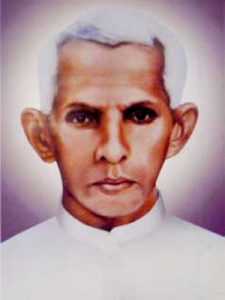 Bl. Kunjachan |
||
| Place of Birth: | Ramapuram | |
| State: | Kerala | |
| Date of Birth | April 1, 1891 | |
| Died On: | October 10, 1973 | |
| Blessed: | April 30, 2006 | |
| Canonized: | ||
| Buried at: | Ramapuram | |
| Feast Day: | 16th October | |
Blessed Kunjachan (Fr. Augustine) was born on 1 April 1891, at Ramapuram in the Syro-Malabar Catholic Diocese of Palai, Kerala, India. He was ordained priest on 17 December 1921.
Fr. Augustine was short of stature and that was the origin of his pet name `Kunjachan' (Little Priest) in the local language, Malayalam. He was just an ordinary priest who could not claim eminence in any field of human activity. But he was humble, kind, service-minded and charitably disposed to the poor and the downtrodden people. He stayed in his own parish, St. Augustine's church Ramapuram as one among the three assistant parish priests for more than 40 years, working specially for the uplift of the Dalits (suppressed people) - the untouchables.
After a brief period of serious illness Kunjachan died on 16 October 1973 at the age of 82. Kunjachan had the reputation of a holy man even while he was alive. People irrespective of caste and religion, used to approach him in their manifold needs and they got favours through his prayers and blessings. Within a few days after his death his tomb at Ramapuram became a centre of pilgrimage for people from far and wide.
The process of Beatification and Canonization started on 11 August 1987 at Ramapuram, bestowing upon him the title, `Servant of God'. The `Positio' on the heroic practice of virtues of the saintly priest was approved by Pope John Paul II on 22 June 2004 and he was declared `Venerable'.
Meanwhile the process of the miraculous cure of the clubfoot of a boy was undertaken, and the findings were sent to Rome for consideration. After a thorough investigation of the miraculous nature of the cure, made by competent personnel in Rome, Pope Benedict XVI approved it, opening the way for Beatification. Venerable Kunjachan was Beatified Card.
| Blessed Devasahayam Pillai | ||
|---|---|---|
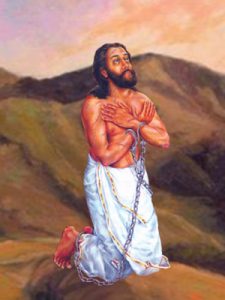 Bl. Devasahayam Pillai |
||
| Place of Birth: | Nattalam | |
| State: | Tamil Nadu | |
| Date of Birth | April 23, 1712 | |
| Died On: | January 14, 1752 | |
| Blessed: | December 2nd, 2012 | |
| Canonized: | ||
| Buried at: | Kottar | |
| Feast Day: | 14 January | |
Blessed Devasahayam Pillai (1712–1752), born Neelakanta Pillai in southern India. Born into a Hindu family in the 18th century, he converted to Christianity and received martyrdom for the Christian faith. Pillai was an official in the court of the king of Travancore, Maharaja Marthanda Varma,when he came under the influence of Dutch naval commander, Captain Eustachius De Lannoy, who instructed him in the Catholic faith. He is believed to have been killed by the then Travancore state for upholding his Christian faith. On June 28, 2012, Pope Benedict XVI authorized the Congregation for the Causes of Saints to promulgate a decree regarding the martyrdom of Devasahayam Pillai and he was referred to as "Venerable".
Devasahayam Pillai is the first lay person to be elevated to the rank of "Blessed" in India.
| Blessed Rodolfo Acquaviva | ||
|---|---|---|
 |
||
| Place of Birth: | Italy | |
| State: | ||
| Date of Birth | 2 October 1550 | |
| Died On: | 25 July 1583 | |
| Blessed: | 1893 | |
| Canonized: | ||
| Buried at: | ||
| Feast Day: | 4 February | |
The son of the Duke of Atri, in Italy's Abruzzi region, Rodolfo Acquaviva (1550-1583) came from an illustrious family related to many of the noble houses of Italy. His uncle Claudio held the position of papal chamberlain in the court of Pope Pius V. The duke negotiated for 17-year old Rudolph to take over that post when the uncle resigned so that he could join the Jesuits. Instead of joining the papal court, however, Rudolph wanted to join the Jesuits. He needed several months to gain his father's consent before he could join the Society of Jesus on April 2, 1568.
After he finished novitiate and his studies in the humanities, philosophy and theology, Acquaviva was assigned to the missions in India. He left Rome for Lisbon, Portugal where he was ordained a priest in early 1578. His first assignment in Goa, India, was teaching philosophy to seminarians at St. Paul's College. Then he was sent on one of the great adventures of the early Society of Jesus: to be missionary to the court of Akbar the Great Mogul.
Akbar had an unquenchable thirst for knowledge and a desire to bring peace and harmony to his subjects, the Moslems and Hindus whose religious beliefs were at odds with each other. So he held weekly religious discussions at his court at Fatephur Sikri, near Agra. When he decided to include Christian theologians in these discussions, he sent emissaries to the Jesuit college in Goa to come to his court and instruct him in the Christian faith.
Father Acquaviva and another Jesuit arrived at Akbar's court in 1580, bringing a seven-volume copy of the Bible and hopes that the conversion of India would follow if they could convert the grand mogul. Akbar was greatly interested in Christianity and seemed convinced of its truth, but was not willing to give up his harem. After three years of effort, Acquaviva decided that Akbar would never be converted. The disappointed Jesuit returned to Goa.
Acquaviva became superior of the 12 Jesuits of the mission in Salsette, a peninsula south of Goa. Missionaries had visited there earlier but received a hostile welcome from the predominantly Hindu population, especially after punitive expeditions destroyed their shrines and temples. The Jesuits decided to start a new campaign to promote conversions and to visit all of the peninsula's 66 villages. They decided to start at the south most village of Cuncolim, but were stopped by a local leader who said they could not enter the village because of internal problems. After waiting some hours and hearing increasingly frightening shouts from the village, the Jesuits decided just to plant a cross on the site of a future chapel and to leave. The people who had been secretly watching them summoned hundreds of angry villagers who surrounded the Jesuits, attacking and killing first Acquaviva and then the other four Jesuits who accompanied him, Fathers Peter Berno, Alphonsus Pacheco, Anthony Francis and Brother Francis Aranha.
| Blessed Dionysius of the Nativity | ||
|---|---|---|
 |
||
| Place of Birth: | Normandy | |
| State: | ||
| Date of Birth | 12 December 1600 | |
| Died On: | 27 November 1638 | |
| Blessed: | 1900 | |
| Canonized: | ||
| Buried at: | ||
| Feast Day: | November 29 | |
Blessed Denis of the Nativity lived between 1600 till 1638 and was born in France. He became a sailor when he was 12 years old and was successful as a pilot-in-chief and cartographer in service to the Kings of France and Portugal. He was also knighted due to his bravery. He became a Carmelite friar taking the name of Dionysius or Denis of the Nativity. He was then sent on a mission to the Sultan of Aceh (Sumatra) by his superiors. However, once he reached there all the members of his party were seized at the instigation of the Dutch authorities. They were tortured and told to renounce their faith, forcing them to become Muslims. All refused and were martyred. Blessed Denis was the last person to be martyred of the group as he desired to strengthen the others. He was killed by a blow to his head by a scimitar. “Jesus, Mary,” were his last words.
| Fr. Redemptus of the Cross, OCD | ||
|---|---|---|
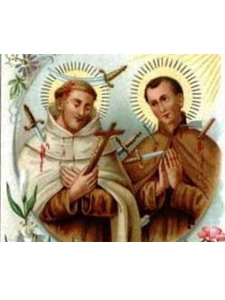 Fr. Redemptus of the Cross, OCD |
||
| Place of Birth: | Portugugal | |
| State: | Braga | |
| Date of Birth | 15 March 1598 | |
| Died On: | 29 November 1638 | |
| Blessed: | 10 June 1900 | |
| Canonized: | ||
| Buried at: | Achen-Jakarta, Indonesia | |
| Feast Day: | ||
Redemptus of the Cross, O.C.D. (also Redemptorus), was a Portuguese lay brother in the Order of Discalced Carmelites. He was put to death along with other members of a group sent to Sumatra by Portuguese authorities. He was born Tomás Rodrigues da Cunha in Paredes de Coura, Portugal on 15 March 1598. He first served as a soldier in the Portuguese army in India, where he joined the Carmelites in Goa as a lay brother in 1615, taking the name Redemptus of the Cross. Brother Redemptus was sent by the superiors of the Order to accompany Father Denis of the Nativity as part of an ambassadorial mission from the Portuguese Empire to the Sultan of Aceh. The mission was led by Dom Francisco Sousa de Castro as ambassador. Once in Aceh, all the members of the mission were seized and arrested,at the instigation of the Dutch authorities based in Jakarta. They were then subjected to torture, and those members of the mission who refused to deny their faith were executed one by one. The two friars were led to a desolate spot on the seashore, where Redemptus was shot with arrows, after which his throat was slit.Father Denis, a crucifix in his hands, was the last to die, his skull shattered by a blow of a scimitar.[
| Blessed Rani Maria Vattalil FCC | ||
|---|---|---|
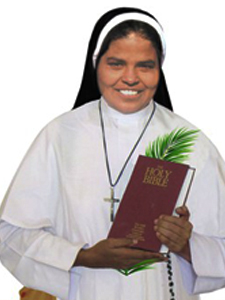 Bl.Rani Maria Vattalil FCC |
||
| Place of Birth: | Pulluvazhy | |
| State: | Kerala | |
| Date of Birth | 29 January 1954 | |
| Died On: | 25 February 1995 | |
| Blessed: | 04 November 2017 | |
| Canonized: | ||
| Buried at: | Udayanagar, Madhya Pradesh | |
| Feast Day: | ||
Sr.Rani Maria, a proud daughter of Pulluvazhy and a professed religious nun of the Franciscan Clarist Congregation (F.C.C.) will be beatified "Blessed Martyr" on 4th November 2017. Sr. Rani Maria was born on 29 January 1954 as the second child of Paily and Eliswa Vattalil, of St.Thomas Parish in the Arch-diocese of Ernakulam - Angamaly of the Syro-Malabar Church. After the initial stages of formation, she made her First Profession on 1 May 1974 and Final Profession on 22 May 1980. She obtained B.A and M.A in sociology in 1982 and 1989 respectively. The motto of her life was: "The Spirit of the Lord is upon me because He has anointed me to preach the Good News to the poor" (Lk.4:18). Imbued with the motto and filled with the mission spirit she worked in the Missions of Bijnor (1975-1983), Oadgady (1983-1992) and Udainagar (1992-1995). Having realized her call within the call Rani Maria wrote: "I am deeply convinced that I am called to work for the poor and the oppressed. I am ready to die for them because they are children of God and as such our sisters and brothers"
Her love for the poor that fructified through various mission activities aimed at individual and social upliftment of the tribal people. However concurrently it went counter to the vested interests of the unscrupulous money-lenders and social exploiters which at last resulted in her martyrdom. She attained the Crown of Martyrdom on 25 February 1995 when Samundar Singh murdered her in a bus in which she was travelling to Indore as she was on her way to Pulluvazhy on Vacation. "By faith, the martyrs gave their lives, bearing witness to the truth of the Gospel that had transformed them and made them capable of attaining the greatest gift of love: the forgiveness of their persecutors". These words of the Holy Father are quite true in the life and martyrdom of Sr. Rani Maria. She lived her Christian faith heroically and her life of charity is an incessant inspiration for many to live their faith. She is a heavenly intercessor for many in their daily struggles to live the Christian faith.
Sr. Rani Maria's Family and Parish showed a marvelous example of Christian forgiveness to Samundar Singh that made him to regret about his heinous crime. According to the text of the approval of the Roman congregation, Sr. Rani Maria's courageous sacrifice and martyrdom has helped to sow "the seed of love, justice and brotherhood in many hearts".
Sr. Rani Maria was beatified a Blessed Martyr on 4th November 2017 at Indore. During the Holy Mass H.E. Angelo Cardinal Amatho S.D.B, prefect of the Congregation for the Saints beatified Sr. Rani Maria publishing the official decree of beatification signed by His Holiness Pope Francis. Sr. Rani Maria is the first women Blessed Martyr of India.
Blessed Mary of the Passion |
||
|---|---|---|
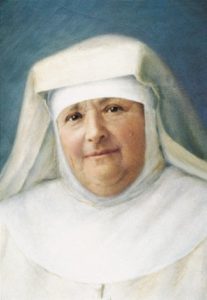 |
||
| Place of Birth: | Nantes, France | |
| State: | Nantes | |
| Date of Birth | 1860 | |
| Died On: | 1904 | |
| Blessed: | 10 October 2002 | |
| Canonized: | ||
| Buried at: | Motherhouse in Rome | |
| Feast Day: | ||
Mary of the Passion was born Helene de Chappotin de Neuville, she came from a distinguished French family in Nantes. In 1860, she entered the Poor Clares, but poor health forced her to leave the following year. In 1864, she joined the Sisters of Mary Reparatrix and took the name Mary of the Passion. From 1865 to 1876, she worked in the Madura missions in India. In 1877, she established the Institute of the Missionaries of Mary, which became the Franciscan Missionaries of Mary (F.M.M.) in 1882 when she adopted the Third Order Rule. Mary was still living when seven members of her community were martyred in the 1900 Boxer Uprising. In addition to caring for people afflicted with leprosy, her sisters have served in education, social service, nursing, and catechetics—frequently with Franciscan Missionaries of Mary of other nationalities. She was beatified in 2002.
